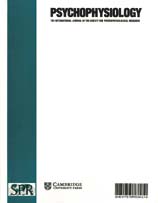Crossref Citations
This article has been cited by the following publications. This list is generated based on data provided by
Crossref.
Tinsley, Christopher J.
and
Everling, Stefan
2002.
The Brain's eye: Neurobiological and clinical aspects of oculomotor research.
Vol. 140,
Issue. ,
p.
61.
Kathmann, Norbert
2004.
Bewegungsstörungen bei Psychischen Erkrankungen.
p.
129.
Sporn, Alexandra
Greenstein, Deanna
Gogtay, Nitin
Sailer, Franziska
Hommer, Daniel W.
Rawlings, Robert
Nicolson, Rob
Egan, Michael F.
Lenane, Marge
Gochman, Peter
Weinberger, Daniel R.
and
Rapoport, Judith L.
2005.
Childhood-onset schizophrenia: smooth pursuit eye-tracking dysfunction in family members.
Schizophrenia Research,
Vol. 73,
Issue. 2-3,
p.
243.
Peleg, Gili
Katzir, Gadi
Peleg, Ofer
Kamara, Michal
Brodsky, Leonid
Hel-Or, Hagit
Keren, Daniel
and
Nevo, Eviatar
2006.
Hereditary family signature of facial expression.
Proceedings of the National Academy of Sciences,
Vol. 103,
Issue. 43,
p.
15921.
Haraldsson, H. Magnus
Ettinger, Ulrich
Magnusdottir, Brynja B.
Sigmundsson, Thordur
Sigurdsson, Engilbert
and
Petursson, Hannes
2008.
Eye movement deficits in schizophrenia.
European Archives of Psychiatry and Clinical Neuroscience,
Vol. 258,
Issue. 6,
p.
373.
Smyrnis, Nikolaos
2008.
Metric issues in the study of eye movements in psychiatry.
Brain and Cognition,
Vol. 68,
Issue. 3,
p.
341.
Calkins, Monica E.
Iacono, William G.
and
Ones, Deniz S.
2008.
Eye movement dysfunction in first-degree relatives of patients with schizophrenia: A meta-analytic evaluation of candidate endophenotypes.
Brain and Cognition,
Vol. 68,
Issue. 3,
p.
436.
Haraldsson, H. Magnus
Ettinger, Ulrich
Magnusdottir, Brynja B.
Ingason, Andres
Hutton, Samuel B.
Sigmundsson, Thordur
Sigurdsson, Engilbert
and
Petursson, Hannes
2010.
Neuregulin-1 genotypes and eye movements in schizophrenia.
European Archives of Psychiatry and Clinical Neuroscience,
Vol. 260,
Issue. 1,
p.
77.
Roche, Daniel J. O.
and
King, Andrea C.
2010.
Alcohol impairment of saccadic and smooth pursuit eye movements: impact of risk factors for alcohol dependence.
Psychopharmacology,
Vol. 212,
Issue. 1,
p.
33.
Ivleva, Elena I.
Morris, David W.
Moates, Amanda F.
Suppes, Trisha
Thaker, Gunvant K.
and
Tamminga, Carol A.
2010.
Genetics and intermediate phenotypes of the schizophrenia—bipolar disorder boundary.
Neuroscience & Biobehavioral Reviews,
Vol. 34,
Issue. 6,
p.
897.
Sanfilippo, Paul G.
Hewitt, Alex W.
Hammond, Chris J.
and
Mackey, David A.
2010.
The Heritability of Ocular Traits.
Survey of Ophthalmology,
Vol. 55,
Issue. 6,
p.
561.
Miller, Gregory A.
2010.
For distinguished contributions to psychophysiology: William G. Iacono.
Psychophysiology,
Levy, Deborah L.
Sereno, Anne B.
Gooding, Diane C.
and
O’Driscoll, Gilllian A.
2010.
Behavioral Neurobiology of Schizophrenia and Its Treatment.
Vol. 4,
Issue. ,
p.
311.
Chakrabarti, Bhismadev
and
Baron-Cohen, Simon
2011.
Variation in the human cannabinoid receptor CNR1 gene modulates gaze duration for happy faces.
Molecular Autism,
Vol. 2,
Issue. 1,
p.
10.
Franco, J.G.
de Pablo, J.
Gaviria, A.M.
Sepúlveda, E.
and
Vilella, E.
2014.
Smooth pursuit eye movements and schizophrenia: Literature review.
Archivos de la Sociedad Española de Oftalmología (English Edition),
Vol. 89,
Issue. 9,
p.
361.
Franco, J.G.
de Pablo, J.
Gaviria, A.M.
Sepúlveda, E.
and
Vilella, E.
2014.
Movimientos de seguimiento ocular lento y esquizofrenia: revisión de la literatura.
Archivos de la Sociedad Española de Oftalmología,
Vol. 89,
Issue. 9,
p.
361.
Law, Phillip C. F.
Paton, Bryan K.
Riddiford, Jacqueline A.
Gurvich, Caroline T.
Ngo, Trung T.
and
Miller, Steven M.
2015.
No Relationship Between Binocular Rivalry Rate and Eye-Movement Profiles in Healthy Individuals: A Bayes Factor Analysis.
Perception,
Vol. 44,
Issue. 6,
p.
643.
Iacono, William G.
Malone, Stephen M.
and
Vrieze, Scott I.
2017.
Endophenotype best practices.
International Journal of Psychophysiology,
Vol. 111,
Issue. ,
p.
115.
Rodríguez-Labrada, Roberto
Vázquez-Mojena, Yaimeé
Canales-Ochoa, Nalia
Medrano-Montero, Jacqueline
and
Velázquez-Pérez, Luis
2017.
Heritability of saccadic eye movements in spinocerebellar ataxia type 2: insights into an endophenotype marker.
Cerebellum & Ataxias,
Vol. 4,
Issue. 1,
Bargary, Gary
Bosten, Jenny M.
Goodbourn, Patrick T.
Lawrance-Owen, Adam J.
Hogg, Ruth E.
and
Mollon, J.D.
2017.
Individual differences in human eye movements: An oculomotor signature?.
Vision Research,
Vol. 141,
Issue. ,
p.
157.


